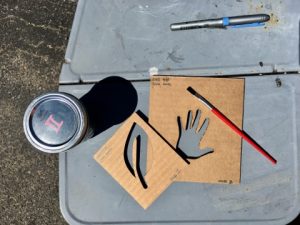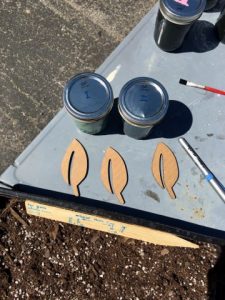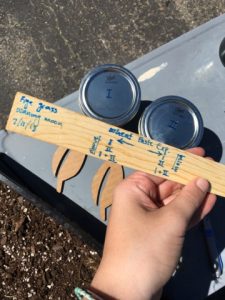July 11
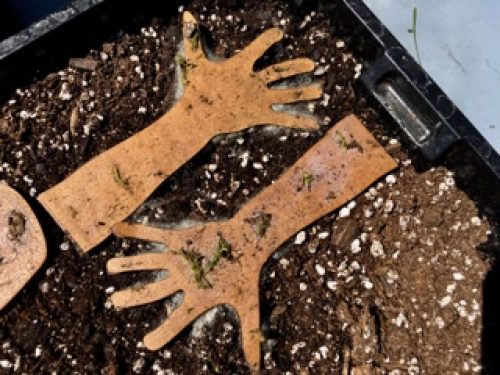
This morning started with the regular routine. I left through my apartment fire exit and descended the three flights of stairs to put my things in my car. Per usual, on my way to my car I stopped to check on my moss experiments that I left in the shade of the first floor porch to give them a misting before heading off for the day. Except this time when I got to the bottom of the porch one of my experiments had gone missing! I scanned the area to see if it had accidentally been knocked out of place but there was no sign of it. As I sprayed the remaining cardboard pieces I noticed the ants scattering from the remaining leaf cut out. It’s the corn syrup, I thought, the ants only go to the one that I mixed corn syrup in. I highly suspect ants are the culprits of the missing cut out as it was one of the pieces coated with the corn syrup concoction.
As for progress in the greenhouse the moss hasn’t seemed to take to the cardboard pieces. The scraps of moss that have been applied are very dried out, and don’t seem to recover after misting morning and afternoon. In addition to this 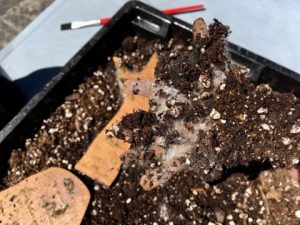 some of the pieces have started to develop a white fuzzy mold along the sides and underneath. These were our first trial hands and were dunked into the original mixture. As a result of the dunking both sides were coated in the mixture which I think resulted in the moss growing along the back side of the cuttings. The mixture these hands were dunked in was also one with a larger amount of buttermilk which could have also resulted in the molding.
some of the pieces have started to develop a white fuzzy mold along the sides and underneath. These were our first trial hands and were dunked into the original mixture. As a result of the dunking both sides were coated in the mixture which I think resulted in the moss growing along the back side of the cuttings. The mixture these hands were dunked in was also one with a larger amount of buttermilk which could have also resulted in the molding.
Apart from the mold fiasco the experimenting has broadened as I made three additional mixtures for the moss graffiti. I tested each mixture on a different leaf. In the image from bottom to top the mixture are: II, III, and IV, with the hands being the original mixture (I). 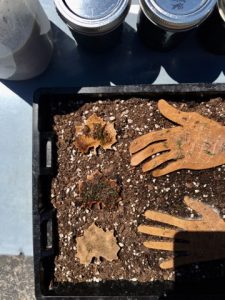
On both the hands and the leaves I try to alternate days of applying more of the mixture, and misting.
All of the experimental mixtures don’t seem to break up the moss enough. I expect it to come out as more of a paste but so far it’s been muddy liquid with some clumps of moss I try to fish out with my paint brush to apply to the cut outs. I wonder if there is a way to make the mixture less muddy as well. I have tried washing out the dirt but large amounts still remain and I don’t try and pull the dirt out from the moss because the moss roots tend to be intertwined with the dirt.
The watery consistency of the mixture also makes it difficult to apply moss stencils to the wall. When the mixture is watery like all four of mine have been they tend to drip down the wall as I try to apply them with a paint brush. I read online that misting the mixture on isn’t as effective and can damage the moss.
The chunks also make it difficult to apply as I have to scoop the chunks with my brush and attempt to stick them to the wall. Here I used my second mixture which contained the same amount of liquid as the original recipe, but larger amounts of moss. After the morning with the ants I thought it would be best to leave the corn syrup mixtures for another time.
 When I read about reapplying the mixtures to help fill the stencil in I realized I had made a mistake with my BLOOM stencil. I couldn’t re-apply the mixture because I hadn’t taken note of where I had place the stencil.
When I read about reapplying the mixtures to help fill the stencil in I realized I had made a mistake with my BLOOM stencil. I couldn’t re-apply the mixture because I hadn’t taken note of where I had place the stencil.
Here I made sure I aligned the stencils with the edges of the cinder blocks to make the reapplication of the mixtures easier, and more accurate.
In addition to the placement I also made sure I marked the stencils I used with what I was using them for, the location I was using them in, and the type of mixture I was applying.
This way I wouldn’t have to worry about picking up the wrong hand stencil and messing up the work I had already done.
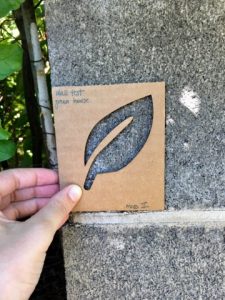 As you can see in the last image these stencils are marked with Moss Test, Green house, and Moss II, so I could easily repeat the steps I’d taken.
As you can see in the last image these stencils are marked with Moss Test, Green house, and Moss II, so I could easily repeat the steps I’d taken.
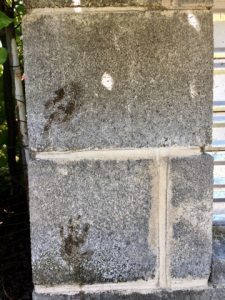
(End result of applying mixture to greenhouse wall)
I also set up an experiment to test out the different wheat pastes I had. The first option (I) was just the original wheat paste that contained 1 cup of flour and 4 cups of water. The second option (II) was the original wheat paste with an addition of dirt that I had sieved the day before. I filled the mason jar about half way with the paste and then added in the dirt in small amount, stirring after each addition until the jar was full.
I set the experiment up into two sections: covered and uncovered. The first two leaves would test each mixture, with the third leaf being a combination of both
I marked a wooden stake with the order each leaf was in, the mixture I applied to them, and indicated which side was covered and uncovered.
In addition, I also marked what kind of seed I was using, the moon’s cycle, and the date.
Here is each leaf after applying each mixture and the seeds. 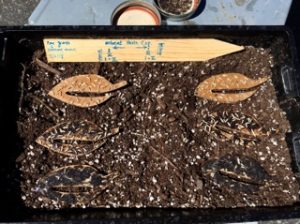
Top: original wheat paste, seeds
Middle: soil paste, seeds
Bottom: wheat paste, seeds, soil paste
I then covered the right hand side with a thin layer of soil. Lastly I watered the leaves with a spray bottle on the mist setting, and placed them in the green house.
